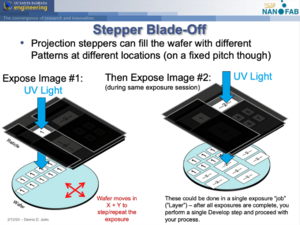Stepper Mask-Making Guidelines (Generic)
Generic Stepper Mask Parameters
Tutorial: If you are not familiar with the difference between designing Contact Litho Masks and Stepper Litho Masks/Reticles, please review this short tutorial:
For the stepper you are designing for, make sure you know:
- Magnification: Our I-Line steppers are typically 5x, and the DUV stepper is 4x reduction.
- The maximum exposure field size, and
- The minimum gap between adjacent patterns/images that must be dark chrome (for the system's reticle shutters to block adjacent images)
- Either the quoted product number from our photomask vendor quotes, or reticle size/thickness/material
- For the GCA Steppers: 5x5x0.090 inches, 5x magnification/reduction, soda-lime glass
- For the ASML PAS 5500/300: 6x6x0.250 inches, 4x magnification/reduction, quartz
- Academic users only: contact Demis for our mask plate quotes. Industrial users must contact photomask vendors themselves to get their own quotes.
These values will vary depending on the stepper you're designing for. Contact the Stepper's Process Expert or Tool Supervisor to find out these values.
Definitions for Mask/Reticle Order Form
When submitting the photo mask order, the following notes & definitions apply:
- "Grade" or "Product Code" will be one of the items on our quote. This will specify the glass type (soda-lime or quartz), plate size (4" square and 0.090" thick, for example), and the resolution. The grade choice determines the price, and is chosen based on required feature size (smaller feature size is more expensive). This is found on the vendor's quote, or you ask the vendor for a price based on desired minimum feature size (smallest feature actually present on your CAD file).
- Although you will submit your CAD file at 1x wafer scale, the actual reticle is printer larger by the stepper's magnification (eg. 4x or 5x mag, depending on the stepper system), so make sure to choose your reticle grade accounting for this; eg. If my CAD has 1.0µm lines smallest feature, I should choose a photomask grade better/equal to 4.0µm for a stepper with 4x reduction.
- “GDS Level” is also known as “layer number”
- "topcell" or "structure name" is which Cell in your CAD file contains the hierarchy of patterns to print.
- Polarity/Mirroring should be "Right-Reading (legible text) with Chrome Down", if your CAD is exactly what you want on the wafer, for all our systems.
- “Min. Feature on Mask” refers to minimum clear or opaque feature, assuming features similar to lines/spaces. This should be at the reticle-scale - see "Grade" above.
- “Min. Contact” refers to features with aspect ratio close to 1:1, eg. Squares and circles. These have a separate spec due to the manufacturing process, so make sure to choose the appropriate grade of photomask with this in mind.
- “CD”, or "Critical Dimension" - Choose a CD similar to your most critical feature (scaled to the 5x/4x reticle scale), so they will print & measure & guarantee test structures at that exact size.
Generic Stepper design/programming CAD files & spreadsheets
- Example Toppan Order Form via Digidat
- Academic users may request the UCSB Nanofab's quotes from various photomask vendors.
- Fill out this Spreadsheet before programming your job on the machine, using your CAD file:
- UCSB_Stepper_-_Programming_Worksheet.pptx - New version of the spreadsheet below, that also includes the wafer-layout info needed to generate a basic stepper exposure program.
- Stepper Reticle Programming Params - MASKJAN2020 v1.xlsx (example for fictional barcode "MASKJAN2020") - Spreadsheet form of the above PPT. Faster to fill out for "expert" stepper users.
- On-wafer alignment marks:
- Please check for the specific Stepper you are using.
- This pattern is usually available on a system reticle - you are not required to include the alignment mark pattern in your own designs, but you may do so if desired.
- Ask the tool supervisor for the CAD file for alignment marks if needed.
Example CAD File and Programming
Using an Example CAD file, here is the corresponding Mask Order Form & Spreadsheet:
- Example CAD file from Utilities > CAD Layout > Example CAD File, designed in KLayout.
- Example "Stepper Reticle Programming Params" spreadsheet for reticle "DEM-2020-03"
- Example Reticle Order Form for reticle "DEM-2020-03"
CAD Tips
- By default, Wafer flat is Down (–Y) with respect to your CAD file for most systems.
- Utilize the "Cell" and "Cell Instancing" functionality in your CAD layout program! (aka. a "Block" in AutoCAD). Highly recommended to use KLayout, not AutoCAD. See Calculators + Utilities > CAD Design Tips for tutorials.
- Center your entire design around the coordinates (0,0). (0,0) should always be the center of your device, wafer and/or photomask/reticle Cells. Photomask vendors should then NOT "auto center" your designs on the plate.
- Inside each sub-Cell, also design around the cell's (0,0) origin.
- Create a Cell called "reticle_layout" or similar, that is an exact representation of what the printed reticle patterns should look like (typically at 1x wafer-scale, if not including the outer templates for the stepper system). Instance the Device's Cells into reticle_layout, and reference this Cell on your mask order form. (You can also Instance the same cells into "device_layout" and "wafer_layout" cells during design/verification.).
- You don't have to include the Stepper outer template - usually photomask vendors can add the reticle-level alignment marks, barcodes etc.; you just send them your 1x wafer-level designs, and instruct the vendor to magnify by 5x/4x, insert into a template for the specified stepper (tell them the model), and they can do the rest.
- For our GCA systems, which we have the full reticle template files for, you can optionally do the 5x magnification and insert into the template file yourself if desired.
If you follow the above rules, your printed "reticle_layout" Cell will have Instances of each of your design's Images/patterns, and the coordinates/sizes of these Cells are exactly what you use to write your Stepper program.
See the example CAD Files here:
